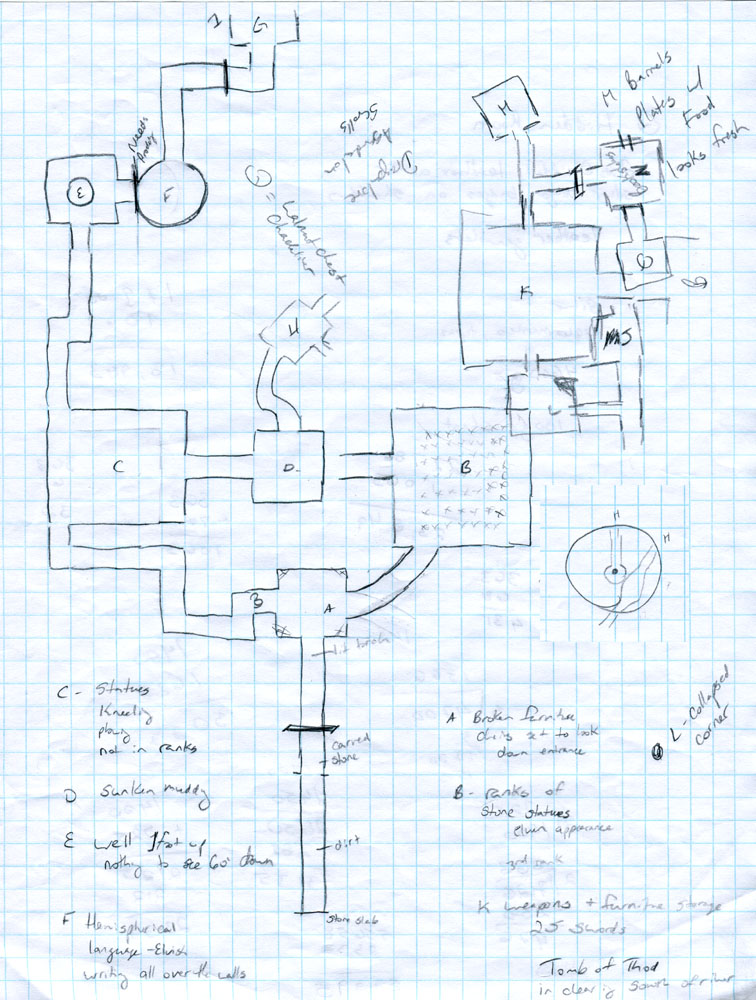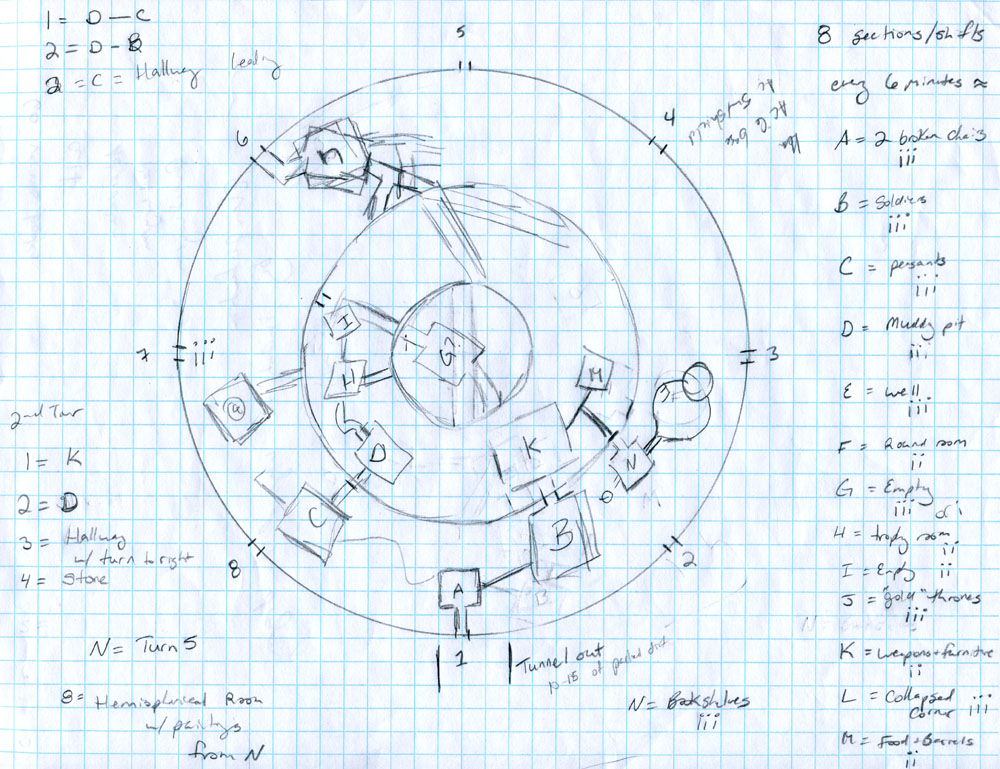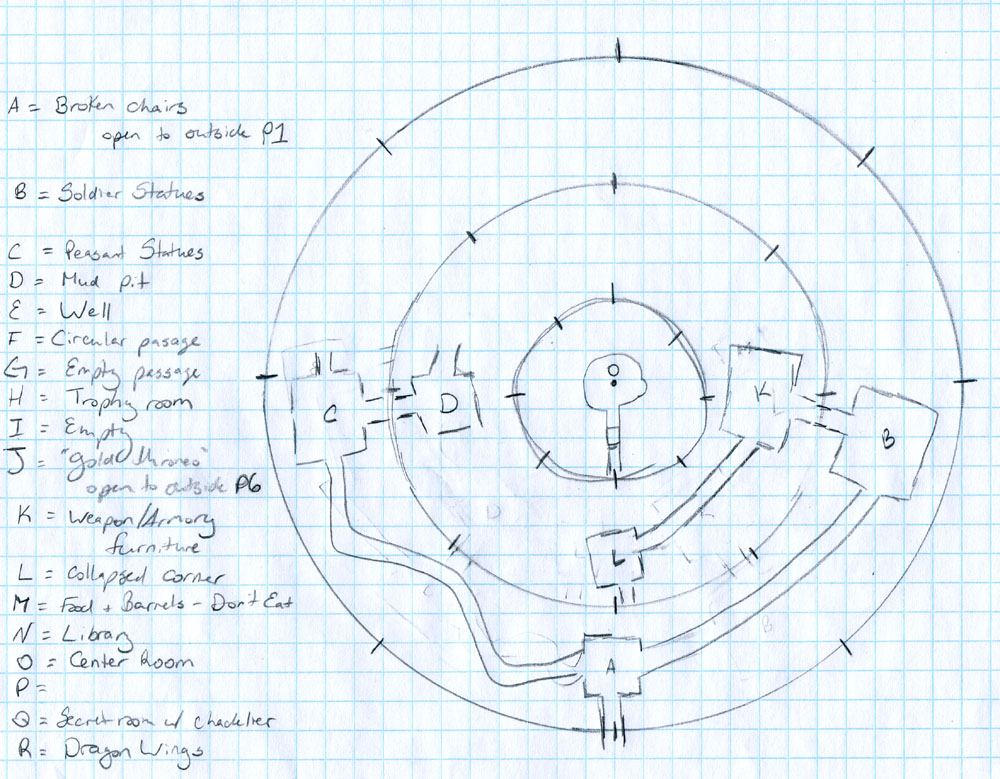A couple days ago I described the first foray of my PCs into the Crypt of Luan Phien, a segmented dungeon which periodically rotates and rearranges its internal layout. As part of that post, I included the maps they drew.
Since then, there have been three return expeditions to the cairn hill, each allowing them to further perfect their understanding of the complex. Because of the unusual nature of the dungeon, I thought people might be interested to see how their maps have evolved:
This is the refinement of their first expeditionary map. Basically charting out their path through the dungeon, while also trying to figure out where the breakpoints in the rotation scheme lay. Analyzing this map allowed the mapper to produce this:
This map, representing the first effort to spatially understand how the segments linked together, went through several revisions, but quickly proved accurate enough to allow them to begin moving through the complex with purpose and intent (instead of hope and abandon).
After their last expedition, the mapper felt she had achieved a deep enough understanding of how the complex was working to further refine the map, resulting in this work-in-progress:
You can see larger versions of each map by clicking on them.
For reference purposes, the letters correspond to the original map as follows: A = 1, B = 2, C = 8, D = trap north of 13, E = 7, F = 12, G = unkeyed area next to 14, H = 13, I = area south of 13, J = 6, K = 10, L = 9, M = 11, N = 4, O = 14, Q = 3, R = 5.
If you’re curious about my peculiar variances in the dungeon, you can also check out my current key for the dungeon in PDF format:
















Its quite interesting to see a map organically develop like this. My players don’t draw enough maps, which I try to use against them as often as possible!
As a side note, the RSS appears to not work, in case you didn’t know.
Hmm… The RSS feed seems to be working for me. Can you tell me what page you’re looking at when you’re clicking the button?
Here’s a link:
http://thealexandrian.net/feed
Justin-
Out of curiosity, do you rely solely on the players expertise when developing maps or do you use some form of skill checks to indicate a character expertise in determining what is going on with an unusual map situation like this one?
I’ve had some really interested conversations with a fellow D&Der about the places we use player expertise and where we use character expertise which has got me asking this question a lot.
Thanks (and thank you for such a regular great read),
poe
In this case it was pretty much entirely player expertise.
When using a system like 3E (which gives better support for GMs making rulings), I typically allow player expertise to activate character expertise. But I will also allow player expertise to trump character expertise.
Hmm… This might be a whole post in itself. Check back tomorrow for a much lengthier treatment of these thoughts.
That is kind of an interesting question.
Personally, I like mapping, and I wouldn’t like having some kind of a character-based check to map an area correctly, because that seems like eliminating one of the major sources of fun. Although if players really aren’t into it, you don’t want to force them, at least not often.
[I remember an old AD&D game I was running, the party was mapping, and due to some problems with … I don’t know, left-right inversion maybe, the party got lost — I mean, REALLY lost — in a “maze” that consisted of two hallways with a single loop. Like, there were only 2 intersections, and they got lost. They kept wandering around and around, and when they were hitting the edge of the graph paper I decided I had to spell it out for them. That was fun in a very meta-game kind of way.]
It is tough, though, because if you’ve got for example PLAYERS that are spatially-challenged, and their very intelligent CHARACTERS are supposed to figure out some complex spatial relationships, it can become a frustrating roadblock. It’s the same kind of problem as in-game riddles, for instance.
I have considered allowing something like Knowledge (dungeoneering) to allow accurate estimates of distance. (Since I often give distances as “20 or 30 feet”, that sort of thing.)
Interesting in theory. In practice it tends to bog down play. But if I did use something like that, it would consciously be one of the “that game play was fun, but let’s do something different” mechanics that D&D level advancement is rife with.
I try to describe distances and dimensions in naturalistic terms — “the end of the tunnel is a good stone’s throw away,” or “the ceiling is about twice as high as you are tall” — and the players can ask for checks if they want their characters to judge the distance accurately. They can use Sight, Survival, etc. as they’re able to justify.
I have a Cartography skill that can help with that, and an Awareness skill that can help visually measure distance; the higher the success, the greater the specificity “at a glance.”
We had a lot of fun with a “redundancy stone” once, as I called it. I told them distances of corridors, and erased and drew in one intersection at a time. Imagine their alarm when they saw boots of a party ahead, not far ahead either. It was like Pooh and Piglet under the jaguar tree.
Thank’s for writing this! I am planning to run this for my players, this will be very useful to have!
@Justin Alexander: How do you present the room information to the players? Do you show them the map or do you just describe to them and tell them to do cartography?
Link to map is now https://www.deviantart.com/djekspek/art/Rotating-Madness-156644839